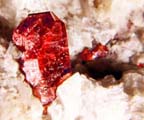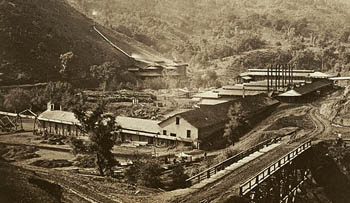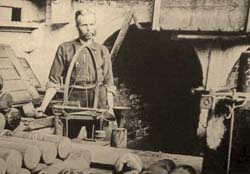 |
Cinnabar: Main Entry: cin·na·bar Pronunciation: 'si-n&-"bär Function: noun Etymology: Middle English cynabare, from Middle French & Latin; Middle French cenobre, from Latin cinnabaris, from Greek kinnabari, of non-Indo-European origin; akin to Arabic zinjafr cinnabar, 1 : artificial red mercuric sulfide used especially as a pigment, 2 : native red mercuric sulfide HgS that is the only important ore of mercury |
Cinnabar, A California History
In 1845, Captain Andres Castillero of the Mexican Army was sent on a routine scouting patrol through what is now northern California, then part of Mexican territory. As an amateur geologist, Castillero recognized the possibility that the rolling hills held vast mineral deposits. During a visit to local Indians, his suspicions were confirmed. The Indians told him of the red rock they used to make paint, and of the cave where the walls were solid deposits of this red rock. A trip to the cave left Castillero amazed; the red rock was cinnabar, high grade mercury ore. He quickly filed a claim with the most suitable local authority, a justice of the peace, and received mineral rights to excavate the mine site. The rights were divided among five principal holders, including Castillero, his guide, and the Indians who led him to the mine.
Unfortunately for Castillero, Mexican land claim regulations were unusually complex, and he found that his claim to the mine could be disputed in court by anyone interested in filing their own claim. This consideration, along with orders from the Mexican Army to prepare for war with the United States, led Castillero to sell his rights to the mine to Barron, Forbes Company, an English industrial firm.
Barron, Forbes Company, which operated a cotton mill in Tepic, Mexico, soon acquired controlling interest in the mine by buying the shares of the other principals. Organized mining operations began at the renamed New Almaden Mines (after the famous Almaden quicksilver mine in Spain) in 1847. It was the first large-scale mining venture in California.

New Almaden proved to be a bonanza. Not only were there huge cinnabar deposits to be mined, but the demand for quicksilver soon skyrocketed. Because of its chemical affinity for gold and silver, mercury was of inestimable value in the refining process of precious metals and was needed throughout the United States, Mexico, and South America. Under the direction of Henry W. Halleck (later a general in the Civil War), the Mexican miners of New Almaden tunneled into the hillside to hammer and blast the cinnabar from the mine walls. Carried or pulled to the surface, tons of ore were roasted in huge furnaces to free the mercury. The silver liquid then passed through condensers into vats, from which it was carefully ladled into seventy-five pound flasks. The operators of the New Almaden Mine were among the most successful entrepaneurs of California 's Gold Rush era.

Much like the founders of the New Almaden Mine, today, Cinnabar Holdings, LLC, seeks out niche investment opportunities in ventures that fufill a broader market need. We felt this name acts as an appropriate analog to our investment strategy and honors our famillial and emotional ties to the San Francisco Bay Area.
Source: New Almaden Mine ( Calif. ) Collection, 1845-1973, New Almaden Mine ( Calif. ) Collection, M0270, Dept. of Special Collections, Stanford University Libraries, Stanford, Calif.
|
